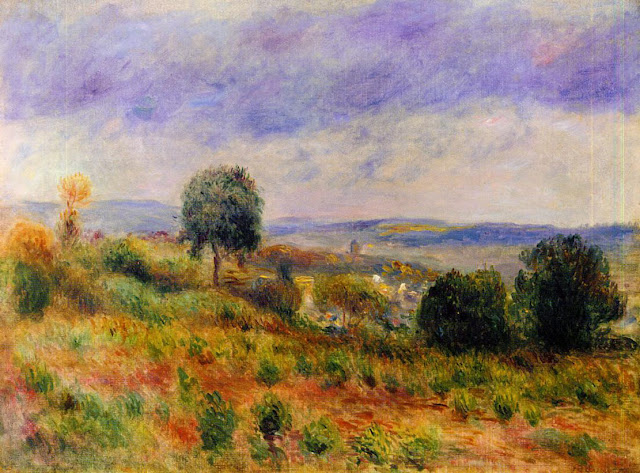Pierre-Auguste Renoir, commonly known as Auguste Renoir (1841 – 1919), was a French artist who was a leading painter in the development of the Impressionist style. As a celebrator of beauty and especially feminine sensuality, it has been said that "Renoir is the final representative of a tradition which runs directly from Rubens to Watteau.”
Pierre-Auguste Renoir was a French Impressionist painter whose eye for beauty made him one of the movement's most popular practitioners. He is best known for his paintings of bustling Parisian modernity and leisure in the last three decades of the nineteenth century. Though celebrated as a colorist with a keen eye for capturing the movement of light and shadow, Renoir started to explore Renaissance painting in the middle of his career, which led him to integrate more line and composition into his mature works and create some of his era's most timeless canvases.
Working alongside Claude Monet, Renoir was essential to developing Impressionist style in the late 1860s, but there is a decidedly human element to his work that sets him apart. Renoir had a brilliant eye for both intimate domesticity and the day's fashions, and his images of content families and well-dressed Parisian pleasure seekers created a bridge from Impressionism's more experimental aims to a modern, middle-class art public.
Renoir was the first Impressionist to perceive the potential limitations of an art based primarily on optical sensation and light effects. Though his discoveries in this field would always remain integral to his art, he reasserted the necessity of composition and underlying structure in modern painting, achieving in his mature work a structured, monumental style that acknowledged the strengths of High Renaissance art.
Renoir's example became indispensible for the major French movements of high modernism: Fauvism and Cubism. Like Renoir, the progenitors of these styles focused on issues of color, composition, and depth rather than quick sketches of individual moments. His composed, vivid paintings created a vital bridge from earlier colorists like Raphael, Peter Paul Rubens, Jean-Antoine Watteau, and Eugène Delacroix to the twentieth-century giants Henri Matisse and Pablo Picasso.
Pierre-Auguste Renoir was a French Impressionist painter whose eye for beauty made him one of the movement's most popular practitioners. He is best known for his paintings of bustling Parisian modernity and leisure in the last three decades of the nineteenth century. Though celebrated as a colorist with a keen eye for capturing the movement of light and shadow, Renoir started to explore Renaissance painting in the middle of his career, which led him to integrate more line and composition into his mature works and create some of his era's most timeless canvases.
Working alongside Claude Monet, Renoir was essential to developing Impressionist style in the late 1860s, but there is a decidedly human element to his work that sets him apart. Renoir had a brilliant eye for both intimate domesticity and the day's fashions, and his images of content families and well-dressed Parisian pleasure seekers created a bridge from Impressionism's more experimental aims to a modern, middle-class art public.
Renoir was the first Impressionist to perceive the potential limitations of an art based primarily on optical sensation and light effects. Though his discoveries in this field would always remain integral to his art, he reasserted the necessity of composition and underlying structure in modern painting, achieving in his mature work a structured, monumental style that acknowledged the strengths of High Renaissance art.
Renoir's example became indispensible for the major French movements of high modernism: Fauvism and Cubism. Like Renoir, the progenitors of these styles focused on issues of color, composition, and depth rather than quick sketches of individual moments. His composed, vivid paintings created a vital bridge from earlier colorists like Raphael, Peter Paul Rubens, Jean-Antoine Watteau, and Eugène Delacroix to the twentieth-century giants Henri Matisse and Pablo Picasso.
 |
 |
| 1862. Sleeping cat |
 |
| 1866. Bouquet of spring flowers |
 |
| 1866. Flowers in a vase |
 |
| 1870. A road in Louveciennes |
 |
| 1874. Camille Monet and her son Jean in the garden at Argenteuil |
 |
| 1874. Landscape between storms |
 |
| 1874. The fisherman |
 |
| 1875. A waitress at Duval's Restaurant |
 |
| 1875. Woman with a parasol in a garden |
 |
| 1876. Dance at Moulin de la Galette |
 |
| 1877. Eugène Murer |
 |
| 1877. The Milliner |
 |
| 1878. Jeanne Samary |
 |
| 1878. Madame Georges Charpentier (Marguérite-Louise Lemonnier, and Her Children, Georgette-Berthe and Paul-Émile-Charles) |
 |
| 1879. Marguerite-Thérèse (Margot) Berard |
 |
| 1880. In the woods |
 |
| 1880. The luncheon of the boating party |
 |
| 1880. View of the Seacoast near Wargemont in Normandy |
 |
| 1881. Still life with peaches |
 |
| 1881. The Doges Palace |
 |
| 1881. The Seine at Chatou |
 |
| 1881. Two Sisters Aka on the terrace |
 |
| 1882. Portrait of Charles and Georges Durand Ruel |
 |
| 1883, By the seashore |
 |
| 1883. Hills around the Bay of Moulin Huet, Guernsey |
 |
| 1883. Reclining nude |
 |
| 1885, In the garden |
 |
| 1888. The daughters of Catulle Mendès, Huguette, Claudine, and Helyonne |
 |
| 1889. Flowers and fruit |
 |
| 1890. Landscape at Vetheuil |
 |
| 1890. The meadow |
 |
| 1890. Two girls reading in the garden |
 |
| 1892. Two young girls at the piano |
 |
| 1892. Young girl bathing |
 |
| 1896. The artist's family |
 |
| 1898. Young spanish woman with a guitar |
 |
| 1901. Landscape Auvers-sur-Oise |
 |
| 1914. Tilla Durieux (Ottilie Godeffroy) |
No comments:
Post a Comment